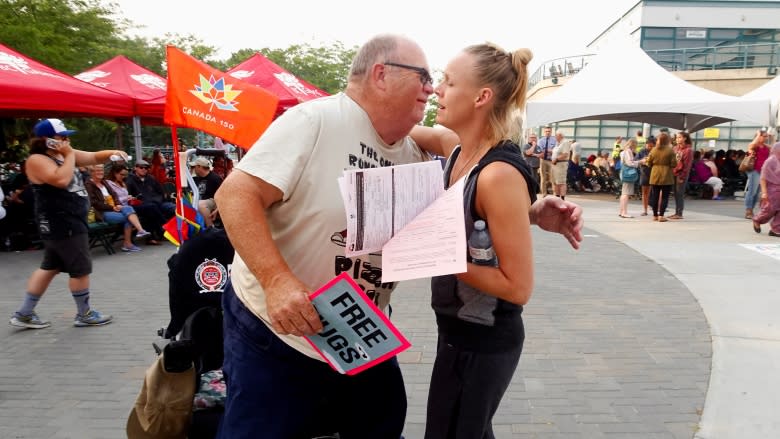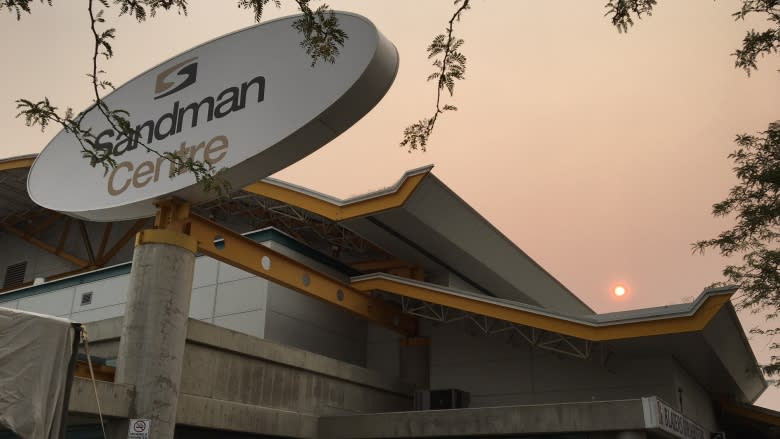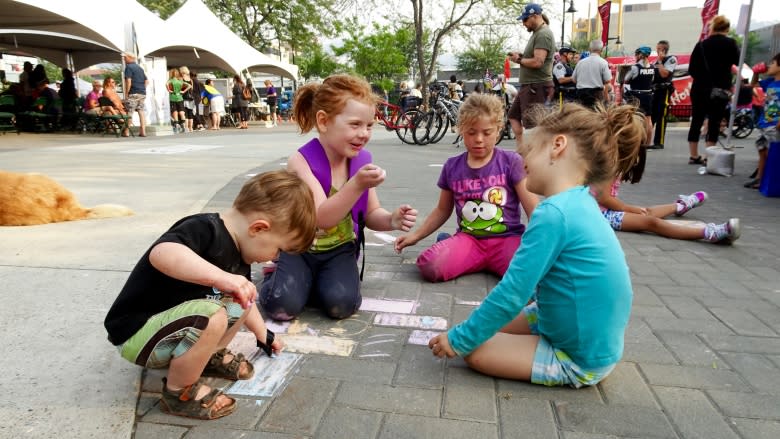Wildfire evacuees in central B.C. brace for news on their homes
- Evacuation alerts and orders from Emergency Info BC
- Road closures and conditions from DriveBC
- Wildfires of note from B.C. Wildfire Service
- Air quality advisories from Environment Canada
After more than a week of waiting, some evacuees from central B.C. may finally learn if their homes are still standing after a wildfire burned through their neighbourhoods.
The entire District of 100 Mile House, which has a population of just under 2,000 people, was evacuated on July 9 as the Gustafsen wildfire inched closer to town.
Eight days later, fire activity in the area had calmed down enough that the local fire chief was able to begin a survey Monday morning of the damage northwest of town, according to Al Richmond of the Cariboo Regional District.
"He'll have those numbers to me sometime this morning, and then we can start to call the folks who've lost their homes," Richmond said.
The district is planning to meet with evacuees in Kamloops and other evacuation centres Monday to inform them about the situation.
For those evacuees whose homes haven't been damaged, there may be more good news on the way, Richmond said.
"We're actively working on re-entry plans for our residents. We're a ways off telling them when they'll be able to come home, but currently the fire situation has calmed down," he said.
Meanwhile, some of those who were ordered out of their homes in Lake Country, north of Kelowna, on Saturday are being allowed to return. Eight homes were destroyed this weekend as a fast-growing grass fire moved through the area.
Smoky skies
Smoky skies greeted central B.C. on Monday morning as firefighters began another week trying to bring wildfires across the region under control.
There's no rain in the forecast until Wednesday night at the earliest, and Environment Canada is cautioning people throughout the Interior and as far east as Saskatchewan about poor air quality due to wildfire smoke.
If rain falls as expected on Thursday, however, it could be as part of a thunderstorm in some parts of the province, potentially bringing lightning that could spark more fires.
Although temperatures are expected to remain relatively cool on Monday, with highs in the low 20s for the hard-hit cities of Williams Lake, Quesnel and 100 Mile House, the forecast calls for warming weather over the next few days. By Wednesday, temperatures could return to the high 20s.
'We're certainly seeing progress'
After strong winds whipped up the flames and caused many of the wildfires to spread aggressively on Saturday, crews were able to make headway during Sunday's calmer conditions, according to B.C. Wildfire Service information officer Kevin Skrepnek.
"We're certainly seeing progress out there, despite the challenges. It's hard progress to quantify," he said.
Though the forecast calls for continuing dry conditions, there are some positives in the outlook for the next few days.
"I don't think we're going to see the wind to the extent of what we saw on Saturday," Skrepnek said. "Of course, the damage has been done in many cases."
Despite promising conditions in the near future, he said those affected by the fires should practice patience
"We want people to be prepared that this is going to be a long-term situation," Skrepnek said.
"No one is more affected than the people who have been displaced. There's a Herculean effort going to support those people.... But the last thing we want to do is bring people back into their homes, only to order them to leave again."
Fires continue to grow
Fifteen of the 159 active fires burning through B.C. were threatening communities by . The largest fire, near Ashcroft, had ballooned to 52,600 hectares in size by Monday morning.
The entire city of Williams Lake was evacuated on Saturday, but about 90 people have yet to leave, according to Mayor Walt Cobb.
A few residents have stuck around to help fight the fires closing in on the outskirts.
Tim Menning runs a timber company in town, and said he's been getting by on bologna sandwiches for the past few days as he helps with the battle.
"It's virtually every logging outfit that has stayed behind ... to help fight the fires," Menning said.
There have been some tough days, with winds whipping up the flames and little progress made in the battle, but conditions were better on Sunday.
"We had a good day yesterday, and today is shaping up OK," Menning said.
According to officials from the wildfire service, none of the blazes circling Williams Lake have managed to reach structures in the city of approximately 10,000 people.
Volunteers feeling worn down
It's difficult to pinpoint exactly how many people have fled their homes, but officials estimate that about 40,000 people have received evacuation orders as the wildfires continue to spread, and another 20,000 are on evacuation alert. Compare that to 2003, B.C.'s worst wildfire season in recent history, when 50,000 were ordered out of their homes.
With news of new evacuation orders and alerts coming in virtually nonstop for the last week and a half, there are signs of fatigue among those trying to help evacuees.
At the Kamloops evacuation reception centre on Sunday afternoon, volunteer Joel Gaudet was feeling worn out after working through the night.
"I've taken a couple of breaks," he said.
"We're still screaming for people to help out here, so I'm not planning on leaving anytime soon."
About 3,000 staff from the B.C. Wildfire Service are helping in the efforts to fight the wildfires, with help from 450 people who have flown in from other provinces. Another 50 specialists and support staff are expected to arrive from Australia on Wednesday.




